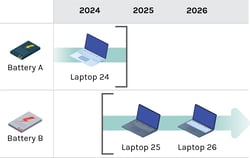 Product roadmaps are essential tools to help manufacturers of all sizes navigate the ever-evolving landscape of innovation and development. The value that dynamic roadmaps deliver will depend on how product teams manage those roadmaps. Making regular updates and tracking key performance metrics (KPIs) is key to ensuring success across the entire product portfolio.
Product roadmaps are essential tools to help manufacturers of all sizes navigate the ever-evolving landscape of innovation and development. The value that dynamic roadmaps deliver will depend on how product teams manage those roadmaps. Making regular updates and tracking key performance metrics (KPIs) is key to ensuring success across the entire product portfolio.
While product managers need to understand and manage all the intricacies of the roadmaps, that level of fine detail is not useful for executives. Manufacturing executives need access to the strategic information that allows them to make better decisions faster.
Let's delve into how product roadmap innovation can quickly and clearly reveal the answers to some of the top questions that manufacturing executives often have about their products, according to the metrics they care about most.
Finding Answers in the Roadmap
 When answering questions about their products, manufacturing executives have a series of KPIs and objectives they care most about. Tracking these goals directly on the product roadmap makes it easy to review each product and assess its performance, health, and potential.
When answering questions about their products, manufacturing executives have a series of KPIs and objectives they care most about. Tracking these goals directly on the product roadmap makes it easy to review each product and assess its performance, health, and potential.
1. Which Plans Need Executive Approval?
Most initiatives require executive approval at various stages – especially those with significant resource requirements or strategic implications. Before approval is given, there must be a demonstration that the product or new feature will bring a worthwhile ROI or contribute to revenue growth or market share.
The roadmap should highlight these metrics and their projections. When executives can filter the portfolio to show plans requiring approval and the metrics attached to them, it makes decisions easier. This ensures that executives are aware of critical decisions awaiting their input, enabling timely reviews and swift action, moving the product closer to production.
2. How Does the Product Benefit the Customer?
Executives want to know why certain products are prioritized over others, with the key concern falling on whether or not the product will satisfy customer needs. The product roadmap should outline the key features of each product model with data and research available to back up each decision. Another metric to include is market share and customer retention.
Knowing that products are aligned with customer needs and wants makes it clear that those products should be kept and improved. If a product does not provide customer satisfaction, product teams can either decide to sunset the model or invest in improvements to fix the problem.
3. What Resources Are Required?
Outlining the product's resource requirements, including budget, personnel, and technology, is part of the product planning process. These details can be assigned to each product on the roadmap, revealing the cost of each unit and the potential profit margin. When financial metrics are clearly visible, it makes it straightforward for executives to assess what is needed to invest in that product. They’ll also know what is necessary to collaborate with other executives to ensure the proper allocation of funds and resources.
4. Are There Component Dependencies?
 Understanding dependencies between different components is crucial for risk management and resource allocation. Manufacturing industries are at a relatively higher risk for time delays due to the complexity of building components in separate facilities or regions or sourcing parts from partner companies. If one piece is delayed, it can have a significant ripple effect on the entire project timeline.
Understanding dependencies between different components is crucial for risk management and resource allocation. Manufacturing industries are at a relatively higher risk for time delays due to the complexity of building components in separate facilities or regions or sourcing parts from partner companies. If one piece is delayed, it can have a significant ripple effect on the entire project timeline.
Executives should have insight into these dependencies to anticipate potential bottlenecks and ensure that their product managers are allocating resources effectively to prevent delays. The roadmap can clearly identify dependencies, enabling executives to have a clear view of problems and discuss solutions with product management teams regarding prioritization and resource allocation.
5. What Is the Timeline of the Product?
While executives don’t need to know every phase of the project timeline, they do want to know key milestones, such as product reviews, customer testing, market launch dates, new feature releases, and important updates. The product roadmap should provide a clear timeline of these upcoming milestones, ensuring transparency and accountability in the development process. When executives can log in and see these milestones and any relevant updates automatically, it reduces the frequency of necessary meetings, emails, and phone calls.
6. Are There Delays in Bringing Components Together?
Delays can be an unavoidable occurrence in product development, but identifying them early is essential for proactive management. The roadmap should transparently communicate any delays, along with the reasons behind them and revised timelines. Executives can then discuss and assess the impact on overall project timelines with product management and make informed decisions to mitigate risks and reallocate resources if necessary.
7. Which Plans Are Phasing Out?
 As market dynamics shift and customer needs evolve, some product plans may no longer align with strategic objectives or deliver expected value. Executives need visibility into product performance, especially customer retention rates, market share, cost per unit, and profit margins. When products are missing these targets on a consistent basis and innovation is not a viable option, a conversation about phasing them out needs to happen. Tracking metrics on the roadmap allows product teams to assess the implications of a phase-out and make decisions about where to allocate resources or invest in new opportunities.
As market dynamics shift and customer needs evolve, some product plans may no longer align with strategic objectives or deliver expected value. Executives need visibility into product performance, especially customer retention rates, market share, cost per unit, and profit margins. When products are missing these targets on a consistent basis and innovation is not a viable option, a conversation about phasing them out needs to happen. Tracking metrics on the roadmap allows product teams to assess the implications of a phase-out and make decisions about where to allocate resources or invest in new opportunities.
8. Which Product Plans Are Active?
Executives often seek clarity on which initiatives are currently in progress to ensure alignment with broader organizational goals. The product roadmap should offer a clear overview of active projects, detailing their scope, milestones, and timelines. By identifying active plans, executives can monitor progress at a high level and allocate resources effectively, ensuring that the company stays on track to deliver value to customers.
Knowing at all times which products are active enables product executives to view the roadmap through various filters, providing insight into which key goals are being met, where approvals for new initiatives need to be prioritized, and where there are opportunities for new ideas.
9. How Are Goals Being Met?
Ultimately, executives want to know whether the company is making progress toward its profit goals, strategic goals, and delivering value to customers. The roadmap should provide visibility into how each initiative contributes to overarching targets, including key performance indicators (KPIs) and objectives and key results (OKRs). Regular updates on goal attainment allow executives to assess progress, identify areas for improvement, and make strategic adjustments as needed.
When product managers build a product roadmap, they can also include important details, such as how the product supports broader strategic initiatives, such as market expansion, revenue growth, or customer retention. Whichever values matter most to the company can be included in product goals directly on the roadmap.
10. What Metrics and KPIs Are Being Used?
We’ve discussed several metrics and KPIs throughout this article, but it’s worthwhile to highlight the key metrics executives are looking for. The product roadmap needs to include key performance indicators (KPIs) and success metrics to determine whether the product vision is on track. These metrics include, but are not limited to, the following:
- Revenue growth
- Profitability and net margins
- Cost per unit
- Market share
- Customer retention
- Customer Satisfaction Score (CSAT)
- Achievement of strategic objectives
Product teams can determine which successful products are meeting the KPIs by tracking results on the product cards inside the product roadmap. Tracking and assessing these metrics makes it easier to keep executives informed on the effectiveness of the product strategy.
How to Provide Product Answers to Executives Using Roadmap Tools
 Product roadmaps are flexible yet powerful tools that can provide executives with the insights they need to make informed decisions and drive strategic initiatives forward when the right tools are used. By addressing these top questions directly within the roadmap, companies can foster transparency, alignment, and agility across the organization, ultimately enhancing their ability to deliver value to customers and achieve long-term success.
Product roadmaps are flexible yet powerful tools that can provide executives with the insights they need to make informed decisions and drive strategic initiatives forward when the right tools are used. By addressing these top questions directly within the roadmap, companies can foster transparency, alignment, and agility across the organization, ultimately enhancing their ability to deliver value to customers and achieve long-term success.
Viewing the product portfolio in different ways makes it easier to read the essential details, providing clear answers to the questions at hand. Here’s how Gocious product roadmap software is providing clarity to executives in all areas of the product portfolio with advanced filtering options:
- By Market: Filter the entire product portfolio by region, segmentation, other other defined markets.
- By Component: Filter products by their components to see where resources need to be allocated, or adjustments need to be made.
- By Dependency: Avoid bottlenecks in the product development process by identifying dependencies and problem-solving for potential delays.
- By Approval Stage: Have executives take decisions sooner by sorting product plans by their approval stage.
- By Alerts: Assign alert notices to problems in the product roadmap to ensure solutions are discussed and found sooner.
- By Phasing In and Out: Keep track of which component will be utilized and which will be phased out.
- By Missing Status: Never miss an important action again by sorting the portfolio by unassigned product cards.
The Product Roadmap Tool Designed for Executive Use
At Gocious, we know that dynamic product roadmap management tools keep internal teams aligned and create transparency across leadership levels. That’s why we’re continually launching new features that give executives the insights they need to stay informed on product development and drive better business outcomes. Schedule your free demo to see how easy it is to filter your portfolio with advanced filtering options.


